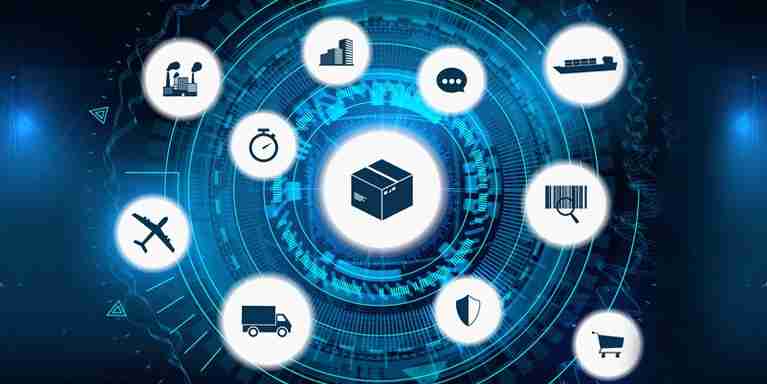In recent years, Blockchain technology has emerged as a game-changer in various industries. One area where Blockchain is proving to be particularly transformative is in supply chain management. The decentralized, tamper-proof, and secure nature of blockchain technology is helping companies streamline their supply chains, reduce costs, increase transparency, and enhance efficiency.
supply chain management and how it works
Supply chain management refers to the coordination and management of all activities involved in the production and delivery of goods and services from suppliers to customers. This includes managing the flow of materials, information, and finances between all parties involved in the supply chain, including suppliers, manufacturers, distributors, retailers, and customers.
In essence, supply chain management involves designing, planning, executing, controlling, and monitoring all activities involved in the supply chain to ensure that products and services are delivered to customers in a timely, efficient, and cost-effective manner. This includes managing inventory levels, transportation, distribution, warehousing, and customer service.
The goal of supply chain management is to optimize the entire supply chain to reduce costs, improve efficiency, and enhance customer satisfaction. By ensuring that all parties involved in the supply chain are working together seamlessly, companies can improve their competitiveness and gain a strategic advantage in the market.
In terms of how it works, supply chain management typically involves a series of interconnected processes and activities, including procurement, production, transportation, warehousing, and distribution. Each of these processes is critical to the success of the supply chain, and companies must ensure that they are optimized to minimize costs, reduce lead times, and meet customer demand.
In order to manage the supply chain effectively, companies typically use a combination of technology, data analytics, and collaboration with suppliers and other partners. By leveraging these tools and strategies, companies can optimize their supply chains and achieve their business objectives.
Changes and advancements in the modern supply chain?
The modern supply chain is evolving rapidly due to advancements in technology and changes in consumer behaviours. One major trend is the increasing use of automation and artificial intelligence to improve efficiency and reduce costs. For example, companies are using robots to automate tasks such as picking and packing and using predictive analytics to optimize inventory levels and reduce waste.
Another trend is the growing importance of sustainability and ethical sourcing in supply chain management. Consumers are becoming more environmentally conscious and are demanding that companies take steps to reduce their carbon footprint and ensure that their products are ethically produced.
As a result, companies are implementing sustainable practices such as using renewable energy and reducing waste, and are implementing ethical sourcing policies to ensure that their suppliers meet certain standards.
Finally, the rise of e-commerce has fundamentally changed the way that products are delivered to customers. Companies are investing in new technologies such as drones and autonomous vehicles to enable faster and more efficient deliveries, and are using data analytics to improve the accuracy of delivery estimates and reduce the risk of delays.
Overall, the modern supply chain is becoming more advanced, efficient, and customer-focused, driven by new technologies and changing consumer demands.

Benefits of blockchain technology to supply chain management
Blockchain technology improves supply chain management by providing a secure and transparent platform for recording and sharing information among different parties involved in the supply chain. Each transaction is recorded in a tamper-proof digital ledger, making it difficult for anyone to manipulate or alter the information.
By using Blockchain technology, supply chain participants can track products from the point of origin to the final destination, ensuring greater visibility and accountability at every stage of the process. This can help to reduce fraud, counterfeiting, and other forms of illegal activity, while also enhancing trust and collaboration among different parties.
In addition, Blockchain technology can enable faster and more efficient transactions by eliminating the need for intermediaries and reducing paperwork. Smart contracts, which are self-executing contracts with the terms of the agreement between buyer and seller being directly written into lines of code, can be used to automate various supply chain processes, such as payment and delivery.
Overall, Blockchain technology has the potential to revolutionize supply chain management by providing a secure, transparent, and efficient platform for recording and sharing information among different parties involved in the supply chain.
The key actors involved in supply chain management using Blockchain technology include:
- Manufacturers:
They create products and record information about the product on the Blockchain, including the source of the raw materials used, manufacturing processes, and quality control information.
- Distributors:
They are responsible for moving products from the manufacturer to retailers or directly to consumers. They can use Blockchain technology to track the movement of products and ensure that they are delivered on time and in good condition.
- Retailers:
They sell products to consumers and can use Blockchain technology to ensure that products are authentic and to trace their origin.
- Consumers:
They can access information about products on the Blockchain, including their origin, quality, and sustainability credentials. This can help them make informed purchasing decisions and support products that align with their values.
- Regulators:
They can use Blockchain technology to monitor and enforce regulations related to product safety, quality, and ethical sourcing. Blockchain can help to ensure that products are compliant with regulatory requirements at every stage of the supply chain.
How does blockchain technology improve traceability within the supply chain?
Blockchain technology enhances traceability in the supply chain by providing a secure and transparent platform for recording and sharing information about the movement of goods from the point of origin to the final destination. Each transaction is recorded on a tamper-proof digital ledger, making it difficult for anyone to manipulate or alter the information.
The use of Blockchain technology can enable supply chain participants to track products at every stage of the process, including the source of the raw materials used, the manufacturing processes, and the movement of products from one location to another. This level of traceability can help to prevent counterfeiting, reduce fraud, and ensure that products are ethically sourced and manufactured.
Smart contracts, which are self-executing contracts with the terms of the agreement between buyer and seller being directly written into lines of code, can be used to automate the tracking of products in the supply chain.
For example, a smart contract can be programmed to release the payment for a product only when it has been verified that the product has been delivered to the intended destination.
Here are some ways in which Blockchain technology enhances traceability in the supply chain:
- Product tracking:
Blockchain allows all participants in the supply chain to track products from the point of origin to the final destination. Each block in the chain contains information about the product, including its origin, production, and movement, making it easy to trace the product’s journey through the supply chain.
- Verification of authenticity:
Blockchain enables the verification of the authenticity of products by providing a digital record of their origin and movement through the supply chain. Participants can use this information to ensure that products are genuine and not counterfeit.
- Transparency:
Blockchain provides transparency in the supply chain by allowing all participants to access the same information about the movement of products. This transparency can help to improve accountability and reduce the risk of fraudulent activities.
- Faster recalls:
In case of a product recall, Blockchain technology can help to quickly identify affected products and trace them back to their source. This can help to reduce the time and cost of recalls, as well as minimize the risk to consumers.
In all, Blockchain technology enhances traceability in the supply chain by providing a secure and transparent platform for recording and sharing information about the movement of goods and products.
It enables all participants in the supply chain to access the same information and helps to improve accountability, reduce fraud, and enhance consumer safety.
How does blockchain improve tradability on the supply chain
Blockchain technology can enhance tradability in the supply chain by providing a secure and transparent platform for conducting transactions and exchanging information. This can help to improve the efficiency and speed of trade, as well as reduce the risk of fraud and errors.
Here are some ways in which Blockchain technology can enhance tradability in the supply chain:
- Smart contracts:
Blockchain allows for the use of smart contracts, which are self-executing contracts with the terms of the agreement written into code. This can help to automate trade processes and reduce the need for intermediaries, resulting in faster and more cost-effective transactions.
- Decentralized marketplaces:
Blockchain enables the creation of decentralized marketplaces where buyers and sellers can connect and transact directly with each other. This can help to reduce transaction costs and improve the speed and efficiency of trade.
- Secure transactions:
Blockchain provides a secure platform for conducting transactions by using encryption and decentralized storage. This can help to reduce the risk of fraud and hacking, as well as ensure the privacy and confidentiality of sensitive information.
- Streamlined customs processes:
Blockchain can help to streamline customs processes by providing a digital platform for storing and sharing customs data. This can help to reduce the time and cost of customs clearance, as well as improve the efficiency and accuracy of trade documentation.
Also the tokenization of assets, Blockchain technology can enable more streamlined and efficient trade, while also increasing transparency and reducing the risk of fraud and errors. This can ultimately lead to greater trust and confidence in the supply chain, as well as increased liquidity and accessibility for investors and financial institutions.
Overall, the enhanced tradability made possible by Blockchain technology has the potential to benefit a wide range of actors involved in the supply chain and financial markets, and could have a significant impact on how goods and services are bought, sold, and traded in the future.
What is the future of blockchain-based supply chain?
Blockchain-based supply chain management has the potential to revolutionize the way businesses operate and interact with their supply chains. By using Blockchain-based systems to track products and materials as they move through the supply chain, businesses can gain greater visibility into their operations and identify any issues or inefficiencies that need to be addressed.
This can lead to more efficient supply chains, reduced costs, and improved customer satisfaction. Additionally, the use of Blockchain technology can increase transparency and traceability, as well as improve security and reduce the risk of fraud.
Overall, the future of Blockchain-based supply chain management looks promising. As more businesses and organizations recognize the benefits of Blockchain-based supply chain management, we can expect to see continued innovation and development in this field.
With increased adoption and integration of Blockchain technology into supply chain operations, businesses can improve efficiency, reduce costs, increase transparency and security, and conduct global trade more easily.
Blockchain supply chain examples
There are a lot of examples of how companies are using Blockchain technology in their supply chain operations to make things more efficient and transparent. For instance, Walmart has been using Blockchain to track their food products since 2018, which helps them trace where everything comes from and recall products quickly if necessary.
Another interesting example is Maersk, a Danish shipping company that partnered with IBM to create a platform called TradeLens. TradeLens lets shipping companies, ports, and customs officials share data and documents securely and easily, which means less paperwork and less hassle for everyone involved.
There are also some really cool examples outside of traditional retail and shipping. De Beers, for example, created a Blockchain-based platform called Tracr that tracks diamonds from the mine to the customer. This lets customers verify the authenticity of their diamonds and ensure that they weren’t mined in conflict zones.
UPS is another company using Blockchain technology in their supply chain, through a partnership with Inxeption. Their platform, Inxeption Zippy, helps small businesses sell their products online by listing their products, managing orders, and tracking shipments with Blockchain.
It’s exciting to see how Blockchain technology is being used in the real world to improve supply chain management, and as more companies adopt these systems, we can expect to see even more innovation and development in this field.
Blockchain for supply chains and international trade.
Blockchain technology can improve international trade by increasing transparency and trust between parties involved in a transaction. For instance, let’s say a company in the United States wants to import goods from a supplier in China.
By using a Blockchain-based platform, both the US company and the Chinese supplier can track the movement of goods in real-time, from the point of origin to the final destination. This creates a transparent and secure record of the entire supply chain, reducing the risk of fraud, delays, and errors.
In addition, Blockchain technology can also facilitate cross-border payments and reduce the need for intermediaries such as banks. Smart contracts can be programmed to automatically execute payment once certain conditions are met, reducing the time and costs associated with traditional payment methods.
Blockchain technology has the potential to streamline international trade and make it more efficient, secure, and transparent.
Supply chain Blockchain projects
here are some examples of Blockchain supply chain projects:
- IBM Food Trust:
This is a Blockchain-based platform that enables food traceability from farm to store. It allows farmers, processors, distributors, and retailers to track food products in real-time and maintain a transparent supply chain.
- Maersk and IBM TradeLens:
This is a Blockchain-based platform that digitizes global supply chain operations. It aims to reduce the time and costs associated with moving goods across borders. The platform provides end-to-end supply chain visibility to all stakeholders and enables them to share data securely.
- De Beers:
The diamond mining company De Beers is using Blockchain to track diamonds from the mine to the retailer. The platform, called Tracr, creates a unique digital identity for each diamond and records its journey through the supply chain. This ensures that diamonds are ethically sourced and that there is no conflict diamonds in the supply chain.
- Everledger:
This is a Blockchain-based platform that provides transparency and traceability to the luxury goods industry. The platform tracks the provenance of luxury goods, including diamonds, fine wines, and artwork. This helps to reduce fraud and counterfeiting in the industry.
- Walmart:
The retail giant Walmart has implemented Blockchain technology in its supply chain to improve food safety. The platform, called the Walmart Food Traceability Initiative, allows Walmart and its suppliers to track the origin of food products, and quickly identify and remove any contaminated products from the supply chain
How to implement blockchain in the supply chain
Implementing Blockchain in the supply chain involves identifying the specific pain points in the supply chain, selecting the appropriate Blockchain platform, and creating a network of participants who can access the data on the Blockchain. Here’s an example of how Blockchain can be implemented in the supply chain:
Walmart, one of the largest retailers in the world, has implemented Blockchain technology in its food supply chain. In 2018, the company announced that it would require its suppliers of leafy greens to use Blockchain technology to track their products from farm to store.
By using Blockchain, Walmart can quickly identify the source of any contaminated products and remove them from the shelves, reducing the time and cost associated with traditional recall methods.
This also ensures greater transparency in the supply chain, as customers can scan a QR code on the product packaging to access information about the farm where the product was grown, the date it was harvested, and the journey it took to reach the store.
This example demonstrates how Blockchain technology can improve traceability and transparency in the supply chain, providing benefits such as improved efficiency, reduced costs, and increased consumer trust.
Blockchain in supply chain case study
One notable case study of Blockchain in the supply chain is the partnership between IBM and Walmart. In 2017, Walmart began requiring all of its suppliers of leafy greens to use IBM’s Blockchain platform to track their products from farm to store.
This was done in response to a deadly E. coli outbreak linked to romaine lettuce, which highlighted the need for greater supply chain transparency and traceability.
Using IBM’s Blockchain platform, suppliers are able to input data at every stage of the supply chain, including where the produce was grown, when it was harvested, and how it was transported.
This information is then recorded on a tamper-proof ledger, allowing Walmart and other stakeholders to track the journey of the product in real time. In the event of a food safety issue, this level of traceability can help to quickly identify the source of the problem and prevent further contamination.








